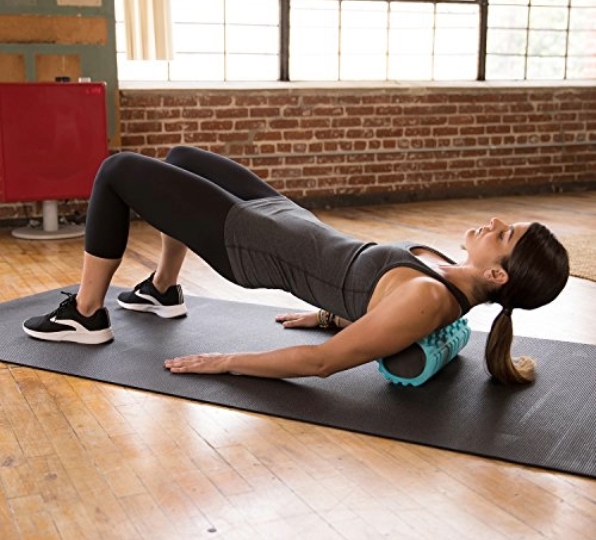Introduction:
Foam rolling is a new and effective self-myofascial release technique in the fitness and rehabilitation fields. This technique entails applying pressure to particular body locations with a cylindrical foam roller in an effort to relieve tension in the fascia, or the connective tissue that surrounds muscles. We’ll examine the science underlying foam rolling in this extensive guide, as well as the numerous advantages it provides for healing and general wellbeing.
1. Understanding Fascia and Myofascial Release
Fascia is a three-dimensional web of connective tissue that surrounds muscles, bones, and organs. Over time, due to factors such as stress, poor posture, and exercise, fascia can become tight and restricted, leading to discomfort and reduced range of motion. Myofascial release, facilitated by foam rolling, aims to alleviate this tension and restore the natural elasticity of the fascial network.
2. Improved Flexibility and Range of Motion
Foam rolling works by breaking up adhesions and knots in the fascia, which can limit joint mobility. Regular use of a foam roller helps to improve flexibility and enhance the range of motion in joints, promoting smoother and more efficient movement during physical activities.
3.Reduction in Muscle Soreness
Engaging in intense workouts can lead to muscle soreness, commonly known as delayed onset muscle soreness (DOMS). Foam rolling after exercise has been shown to reduce muscle soreness by promoting blood flow to the muscles and aiding in the removal of waste products, such as lactic acid, that accumulate during physical exertion.
4.Enhanced Blood Circulation
Foam rolling acts as a form of self-massage, stimulating blood flow to the muscles. Increased circulation brings a fresh supply of oxygen and nutrients to the tissues, facilitating faster recovery and reducing inflammation.
5.Breakdown of Trigger Points
Trigger points, or muscle knots, can develop in response to overuse or muscle imbalances. Foam rolling targets these trigger points, applying pressure to release the tension and promote relaxation in the affected muscles. This can alleviate pain and discomfort associated with trigger points.
6. Prevention of Injuries
Regular foam rolling can contribute to injury prevention by addressing imbalances and tightness in the muscles. By maintaining optimal muscle length and flexibility, individuals are less prone to injuries caused by overuse or improper movement patterns.
7. Enhanced Posture and Body Awareness
Foam rolling promotes body awareness by encouraging individuals to tune into their muscles and identify areas of tension. This heightened awareness, coupled with improved flexibility, can contribute to better posture and alignment, reducing the risk of musculoskeletal issues.
8. Stress Reduction and Relaxation
The act of foam rolling is not only physical but also has a relaxing effect on the nervous system. It can be a meditative practice, allowing individuals to unwind and release built-up tension, making it an excellent addition to a post-workout cooldown routine or an evening relaxation ritual.
9. Accessibility and Cost-Effectiveness
One of the key advantages of foam rolling is its accessibility. Foam rollers are affordable, and the practice can be done in the comfort of one’s home. This makes it a cost-effective and convenient tool for individuals seeking an efficient method of self-myofascial release.
10.Customizable to Individual Needs
Foam rolling is a versatile practice that can be tailored to individual needs. Whether targeting specific muscle groups, focusing on trigger points, or incorporating various rolling techniques, individuals can personalize their foam rolling routine to address their unique areas of tension and discomfort.
11. Aid in Recovery for Various Activities
Foam rolling is beneficial for a wide range of physical activities, from running and weightlifting to yoga and high-intensity interval training (HIIT). Athletes across different disciplines incorporate foam rolling into their routines to support recovery and optimize performance.
12. Long-Term Benefits for Overall Well-being
Consistent foam rolling offers long-term benefits for overall well-being. Beyond immediate recovery from workouts, the practice contributes to maintaining healthy muscle tissue, reducing the risk of chronic injuries, and supporting a more active and pain-free lifestyle.


Conclusion:
Incorporating foam rolling into your fitness routine is more than a trend; it’s a science-backed practice that can significantly impact your recovery, flexibility, and overall well-being. By understanding the principles of myofascial release and embracing the benefits of foam rolling, individuals can empower themselves to take an active role in their muscular health. As you roll out the kinks and release tension, you’re not just improving your physical state; you’re investing in a holistic approach to recovery that extends beyond the gym. So, grab your foam roller, carve out a few minutes in your day, and embark on a journey to unlock the power of self-myofascial release for enhanced recovery and a more resilient, flexible, and pain-free body. Your muscles will thank you, and your body will feel the difference.












